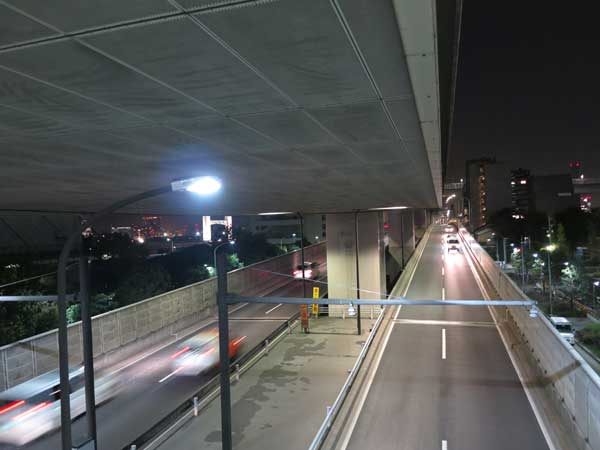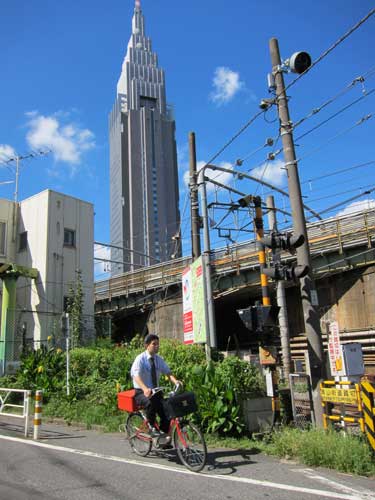
Recently I heard Mishima Yoshiki present a paper about the revival of the Kyobashi river in central Tokyo. Like most of Tokyo’s legendary rivers and canals, it has long been buried underground, when the Edo tradition of water transportation gave way to twentieth century freeways for private autos and commercial trucks.

Mishima’s paper was presented at the Tokyo University’s Asia Mega-Cities symposium in a session devoted to urban rivers. His paper was co-authored with Hayashi Masaki, Shikanai Kyoko, and Ishikawa Mikiko. Mishima is a PhD candidate at Todai’s graduate school of engineering, and a landscape architect trained at the Harvard Graduate School of Design.
Many landscape architects and urban historians point to the centrality of water in Tokyo’s history, and there is a growing desire to see its renewal in our post-industrial era. Mishima’s talk highlighted the Edo functions of the Kyobashi river, the history of its “reclamation” or burial, and the opportunities to remake it today.

Mishima’s project team chose the Kyobashi river because it is in central Tokyo and it is relatively short, with a history of connecting the Edo castle to the ocean. The paper introduced the concept of the kashi, a riverside commons that served as a place for unloading goods and commercial markets and where no private structures were allowed to be created. Today it has exceptional potential because it represents a mere 600 meters of the 320 kilometer Tokyo Expressway system, and is used by only 4,000 of the 53,000 daily expressway vehicles. Plus, its central location offers enormous potential as public open space and high rent commercial space.

Mishima explained how the Kyobashi river, like most of Tokyo’s waterways, became devalued and ultimately buried in the twentieth century when natural and human disasters overwhelmed the city. The 1923 Kanto Earthquake destroyed the kashi, and many private buildings were constructed. River commerce had already declined, and increasing garbage raised sanitation problems. The firebombing of Tokyo during World War II left huge piles of ashes along the river banks, making open space again a place for waste.

The post-war period saw some bizarrely futuristic plans. The 1950 “Sky Building Plan” envisioned building twelve story buildings above the old river, with an expressway running through the second floor. I am curious why this plan was ultimately rejected. In its stead, the city built a series of elevated freeways, mostly public and some privately owned, with several including the Kyobashi river having commercial tenants on the ground floor.
I enjoyed seeing the model of the renewal of the Kyobashi river. Using rainwater, treated sewage, and springs, there were would be plenty of water to support the new river. Water is constantly being pumped out from the subway tunnels (this happens in New York City as well, which I learned in the fantastic book The World without Us by Alan Weisman).
The Kyobashi river concept combines commercial development with the creation of a huge new green corridor. Some buildings would be placed on the new river, as a way to generate revenue for the construction and maintenance of the new public spaces. Green roofs would integrate the new buildings with the park. People would have access to the river on bridges, plazas, water decks, and recreational boats. It would be great to also see a river edge that combined some elements of natural riverbank vegetation and habitat.
Several factors make the idea of this project at least conceivable. One, the Kyobashi river area is small and borders high rent Ginza. Second, the elevated freeway, like most of Tokyo’s expressways, was built in the rush to “modernize” before the 1964 Tokyo Olympics. Therefore, they do not meet current earthquake standards, and the city currently faces a choice between expensive retrofitting or potential collapse. (The earthquake damage to San Francisco’s Embarcadero freeway in 1989 provided the impetus for freeway removal and opening the bay to the city in the early 2000s, which has been a huge success). Lastly, the low rent payed by the private company suggests that the Tokyo Metropolitan Government and its residents receive minimal compensation in exchange for the environmental costs of the freeway.











 東京の中には、たくさんのあまりきれいでないものがあります。とても高い電線は江戸時代の五日市街道の上を渡ります。ごみ焼却炉の煙突や高架道路やマンションの終わらない蛍光灯の列も都市生活に奇妙なリズムをつくります。このとても高い電線の下に柿の実が見えます。
東京の中には、たくさんのあまりきれいでないものがあります。とても高い電線は江戸時代の五日市街道の上を渡ります。ごみ焼却炉の煙突や高架道路やマンションの終わらない蛍光灯の列も都市生活に奇妙なリズムをつくります。このとても高い電線の下に柿の実が見えます。



















